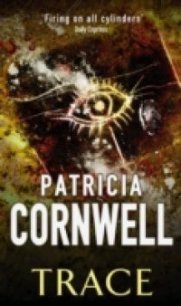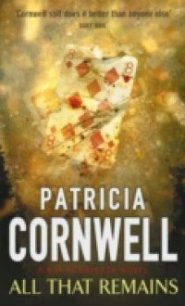Cruel and Unusual - Cornwell Patricia (читать книги без регистрации полные .txt) 📗
“Who was paying her?”
“Maybe you were.”
“That's ridiculous,” I said calmly. “You and Susan were involved in some money-making scheme, and my guess is that you are the one who initially got her involved because you knew her vulnerabilities. She probably had confided in you. You knew how to convince her to go along, and Lord knows you could use the money. Your bar tabs alone have got to blow your budget. Partying is very expensive, and I know what you get paid.”
“You don't know anything.”
“Ben.”
I lowered my voice. “Get out of it. Stop while there's still time to tell me who's behind It.”
He would not look me in the eye.
“The stakes are too high when people start dying. Do you think ft you killed Susan that you'll getaway with it?”
He said nothing.
“If someone else killed her, do you think you're immune, that the same thing can't happen to you?”
“You're threatening me.”
“Nonsense.”
“You can't prove that the cologne you smelled on Susan was mine. There's no test for something like that.
You can't put a smell in a test tube; you can't save it;' he said.
“I'm going to ask you to leave now, Ben.”
He turned and walked out of his office. When I heard the elevator doors shut, I went down the hall and peered out a window overlooking the parking lot in back. I did not venture out to my car until Stevens had driven away.
The FBI Building is a concrete fortification at 9th Street and Pennsylvania Avenue in the heart of D.C., and when I arrived the following morning, it was in the wake of at least a hundred noisy schoolchildren. They brought to mind Lucy at their age as they stomped up steps, dashed to benches, and flocked restlessly about huge shrubs and potted trees. Lucy would have loved touring the laboratories, and I suddenly missed her intensely.
The babble of shrill young voices faded as if carried away from me by the wind, my step brisk and directed, for I had been here enough times to know the way. Heading toward the center of the building, I passed the courtyard, then a restricted parking area and a guard before reaching the single glass door. Inside was a lobby of tan furniture, mirrors, and flags. A photograph of the president smiled from one wall, while posted on another was a hit parade of the ten most wanted fugitives in the land.
At the escort desk, I presented my driver's license to a young agent whose demeanor was as grim as his gray suit.
“I'm Dr. Kay Scarpetta, Chief Medical Examiner of Virginia.”
“Who are you here to see?” I told him.
He compared me to my photograph, ascertained that I was not armed, placed a phone call, and gave me a badge. Unlike the Academy at Quantico, Headquarters had an ambience that seemed to starch the soul and stiffen the spine.
I had never met Special Agent Minor Downey, though the irony of his name had conjured up unfair images. He would be an effete, frail man with pale blond hair covering every inch of his body except for his head. His eyes would be weak, his skin rarely touched by the sun, and of course he would drift in and out of places and never draw attention to himself. Naturally, I was wrong. When a fit man in shirtsleeves appeared and looked straight at me, I got up from my chair.
“You must be Mr. Downey,” I said.
“Dr. Scarpetta.”
He shook my hand. “Please call me Minor.”
He was at the most forty, and attractive in a scholarly sort of way, with his rimless glasses, neatly clipped brown hair, and maroon-and-navy-striped tie. He exuded a prepossession and intellectual intensity immediately noticeable to anyone who has suffered through arduous years of postgraduate education, for I could not recall a professor from Georgetown or Johns Hopkins who did not commune with the uncommon and find it impossible to connect with pedestrian human beings.
“Why feathers?” I asked as we boarded the elevator.
“I have a friend who's an ornithologist at the Smithsonian's Museum of Natural History,” he said. “When government aviation officials started getting her help with bird strikes, I got interested. You see, birds get ingested by aircraft engines and when you're going through the wreckage on the ground, you find these feather parts and want to figure out which bird caused the problem. In other words, whatever got sucked in was chewed up pretty good. A sea gull can crash a B-1 bomber, and you lose one engine to a bird strike with a wide-bodied plane full of people and you've got a problem. Or take the case of the loon that went through the windshield of a Lear jet and decapitated the pilot. So that's part of what I do. I work on bird ingestions. We test turbines and blades by throwing in chickens. You know, can the plane survive one chicken or two? But birds figure into all sorts of things. Pigeon down in poop on the bottom of a suspect's shoes - was the suspect in the alleyway where the body was found or not? Or the guy who stole a Double Yellow Amazon during the course of a burglary, and we find down pieces in the back of his car that are identified as coming from a Double Yellow Amazon. Or the down feather recovered from the body of a woman who was raped and murdered. She was found in a Panasonic stereo speaker box in a Dumpster. The down looked like a small white mallard feather to me, same type of feather in the down comforter on the suspect's bed. That case was made with a feather and two hairs.”
The third floor was a city block of laboratories where examiners analyzed the explosives, paint chips, pollens, tools, tires, and debris used in crimes or collected from scenes. Gas chromatography detectors, microspectrophotometers, and mainframes ran morning, noon, and night, and reference collections filled rooms with automotive paint types, duct tapes, and plastics. I followed Downey through white hallways past the DNA analysis labs, then into the Hairs and Fibers Unit where he worked. His office also functioned as a laboratory, with dark wood furniture and bookcases sharing space with countertops and microscopes. Walls and carpet were beige, and crayon drawings tacked to a bulletin board told me this internationally respected feather expert was a father.
Opening a manila envelope, I withdrew three smaller envelopes made of transparent plastic. Two contained the feathers collected from Jennifer Deighton's and Susan Story's homicides, while a third contained a slide of the gummy residue from Eddie Heath's wrists.
“This is the best one, it seems,” I said, pointing out the feather I had recovered from Jennifer Deighton's nightgown.
He took it out of its envelope and said, “This is down a breast or back feather. It's got a nice tuft on it. Good. The more feather you've got, the better.”
Using forceps, he stripped several of the branchlike projections or “barbs” from both sides of the shaft and, stationing himself at the stereoscopic microscope, placed them on a thin film of xylene that he had dropped on a slide. This served to separate the tiny structures, or float them out, and when he was satisfied that each barb was pristinely fanned, he touched a corner of green blotting paper to the xylene to absorb it. He added the mounting medium Flo-Texx, then a coverslip, and placed the slide under the comparison microscope, which was connected to a video camera.
“I'll start off by telling you that the feathers of all birds have basically the same structure,” he said. “You've got a central shaft, barbs, which in turn branch into hairlike barbules, and you've got a broadened base, at the top of which is a pore called the superior umbilicus. The barbs are the filaments that result in the feather's feathery appearance, and when they're magnified you'll find they're actually like minifeathers coming out of the shaft.”
He turned on the monitor. “Here's a barb.”
“It looks like a fern,” I said.
“In many instances, yes. Now we're going to magnify it some more so we can get a good look at the barbules, for it is the features of the barbules that allow for an identification. Specifically, what we're most interested in are the nodes.”



